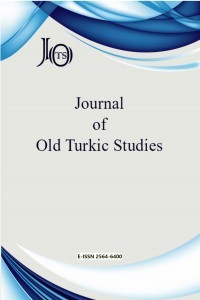Some Explanations on Yenisey Inscriptions
Yenisey Inscriptions, qıyɣ(a)n, ičräki, q(ı)zɣ(a)q, um(a)y b(ä)g(i)miz, alt(u)n, s(u)ŋa, uy(u)r
Yenisey Yazıtları Üzerine Bazı Açıklamalar
Yenisey Inscriptions, qıyɣ(a)n, ičräki, q(ı)zɣ(a)q, um(a)y b(ä)g(i)miz, alt(u)n, s(u)ŋa, uy(u)r,
___
- ARAT, R. R. (1946). Gazi Zahirüddin Muhammed Babur: Vekayi Babur’un Hâtiratı II, Ankara: Türk Tarih Kurumu Basımevi.
- ARAT, R. R. (1947). Kutadgu Bilig I: Metin, İstanbul: Milli Eğitim Basımevi.
- ARAT, R. R. (1959). Kutadgu Bilig II: Tercüme, Ankara: Türk Tarih Kurumu Basımevi.
- ASPELIN, J. R. (1889). Inscriptions de l’Iénissei, Récueillies et publiées par la Société Finlandaise d’Archeologie, Helsingfors 1889.
- AYDIN, E. (2015). Yenisey Yazıtları, Konya: Kömen Yayınları.
- BANG, W.; A. von GABAIN (1928). “Ein uigurisches Fragment über den manichäischen Windgott”, Ungarische Jahrbücher, 8/3-4: 246-256.
- BATMANOV, I. A. (1959). Yazık Yeniseyskih Pamyatnikov Drevne Tyurkskoy Pismennosti, Frunze: Akademiya Nauk.
- CLAUSON, Sir G. (1972). An Etymological Dictionary of Pre-Thirteenth Century Turkish, Oxford: Oxford University Press.
- ERDAL, M. (1991). Old Turkic Word Formation, a Functional Approach to the Lexicon, Vol. 1-2, Wiesbaden: Harrassowitz Verlag.
- GÖMEÇ, S. (1989). “Umay Meselesi”, Türk Kültürü, 318: 630-634.
- KYZLASOV, İ. R. (1998). “İzobrajeniye Tengri i Umay na Sülekskoy pisanniye”, Etnografiçeskoye Obozreniye, 4: 39-53.
- KLYASHTORNIY, S. G. (1976). “Drеvnеyşiyе dаtirovаnnıyе pаmyatniki Yenisеyskoy runiçеskoy pismеnnosti”, Yazıki i Toponimiya, Vıpusk 1, Тomsk: 156-157.
- KORMUSHIN, İ. V. (1997). Tyurkskiye Yeniseyskiye Epitafii, Tekstı i Issledovaniy, Moskva: “Nauka”.
- KORMUSHIN, İ. V. (2008). Tyurkskiye Yeniseyskiye Epitafii, Grammatika, Tekstolo-giya, Moskva: “Nauka”.
- KUNAA, A. Č.; O. V. SUBRAKOVA (1963). Pamyatniki Drevnetyurkskoy Pismennosti Tuvı, Kızıl.
- MALOV, S. Y. (1952). Yeniseyskaya Pis’mennost Tyurkov, Teksti i Perevodi, Moskva-Leningrad: Izd. Akademii Nauk SSSR.
- ORKUN, H. N. (1940). Eski Türk Yazıtları 3, İstanbul: Alaeddin Kıral Basımevi.
- POTAPOV, L. P. (1973). “Umay-Bojestvo drevnih Tyurkov v svete etnografiçeskih dannıh, Tyurkologiçeskiy Sbornik 1972: 265-286.
- POTAPOV, L. P. (1991). “Umay”, Altayskiy Shamanizm, Nauka, Leningrad: 84-298.
- RADLOFF, W. (1892-1899). Atlas Drevnostey Mongolii, Trudi Orhonskoy Ekspeditsii, St. Petersburg.
- RADLOFF, W. (1895). Die Alttürkischen Inschriften der Mongolei [1], Die Denkmäler von Koscho-Zaidam (Dritte Lieferung), Verbesserungen, Zusätze und Bemerkungen zu den Denkmälern von Koscho-Zaidam, die übrigen Denkmäler des Orchon-Beckens und die Denkmäler im Flussgebiete des Yenissey, St. Petersburg: Eggers.
- RECEBOV, E.; J. MEMMEDOV (1993). Orhon-Yenisey Abideleri, Bakı: Bakı Yazıçı.
- SINOR, D. (1984). “Umay a Mongol Spirit Honored by the Türks”, Proceedings of the International Conference on China Border Area Studies, National Chengchi University, Taipei: 1771-1781.
- ŞEMEN, S. (2015). “E-4 (Ottuk-Daş) Yazıtı Üzerine”, Türk Dili ve Edebiyatı Dergisi, 51: 137-146.
- ŞİRİN, H. (2016). Eski Türk Yazıtları Söz Varlığı İncelemesi, 2th Edition, Ankara: Türk Dil Kurumu Yayınları.
- TEKİN, T. (2004). Makaleler II: Tarihi Türk Yazı Dilleri, Ankara: Türk Dil Kurumu Yayınları.
- TEKİN, T. (2013). Irk Bitig: Eski Uygurca Fal Kitabı, Ankara: Türk Dil Kurumu Yayınları.
- USEYEV, N. (2011). Yenisey Cazma Estelikteri I: Leksikası Cana Tekstter, Bishkek.
- VASİLYEV, D. D. (1983). Korpus Tyurkskih Runiçeskih Pamyatnikov Basseyna Yeniseya, Leningrad: Akademiya Nauk SSSR.
- VASİLYEV, D. D. (1983b). Grafiçeskiy Fond Pamyatnikov Tyurkskoy Runiçeskoy Pismennosti Aziatskogo Areala, Moskva.
- YILDIRIM, F. et al (2013). Yenisey-Kırgızistan Yazıtları ve Irk Bitig, Ankara: BilgeSu.
- YUDAHIN, K. K. (1948), Kırgız Sözlüğü, Çev. A. TAYMAS, Vol. 1-2, Ankara: Türk Dil Kurumu Yayınları.
- Yayın Aralığı: Yılda 2 Sayı
- Başlangıç: 2017
- Yayıncı: Erdem UÇAR
Some Explanations on Yenisey Inscriptions
Eski Türk Yazıtlarındaki Kağan Seçme Ritüelinin İzleri Üzerine
Eski Uygurcada İlk Hecedeki Yuvarlak Ünlülerin Yazıçevrimi Problemi Üzerine
Uygurlarda Maniheizm Etkisi Altında Gelişen Din-Devlet İlişkisi
A Tale from the Pañcatantra in Central Asia? The Lion, the Bull and the Fox
Sir Gerard Clauson’un Sözlüğündeki ‘Muhtemel Etimolojiler’ Üzerine
